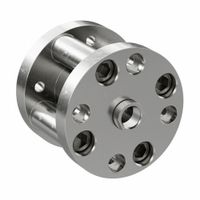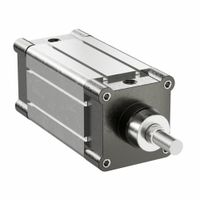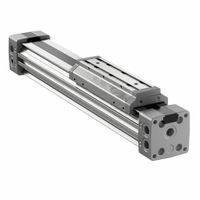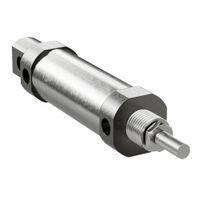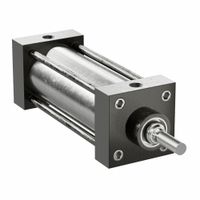Call +(254) 703 030 000 / 751 483 999 / 721 704 777
- Home
- Pneumatics
- Pneumatic Actuators
- Air Cylinders
.....Read More
Frequently Asked Questions
What are the different types of air cylinders?
Air cylinders, also known as pneumatic cylinders, are devices that use compressed air to produce a force in a reciprocating linear motion. The different types of air cylinders include:
1. **Single-Acting Cylinders**: These cylinders use air pressure to move the piston in one direction, with a spring or external force returning it to the original position.
2. **Double-Acting Cylinders**: Air pressure is used to move the piston in both directions, allowing for more control and power in both the extension and retraction strokes.
3. **Telescopic Cylinders**: These are multi-stage cylinders that provide a longer stroke from a compact retracted length, ideal for applications with limited space.
4. **Rodless Cylinders**: The piston is connected to an external carriage, allowing for a longer stroke without the need for a protruding rod, useful in space-constrained environments.
5. **Rotary Cylinders**: These convert linear motion into rotational motion, suitable for applications requiring rotational movement.
6. **Compact Cylinders**: Designed for applications where space is limited, these cylinders have a shorter body and are often used in tight spaces.
7. **Guided Cylinders**: Equipped with guide rods to prevent rotation and provide stability, these are used in applications requiring precise linear motion.
8. **Clamping Cylinders**: Used to hold or clamp objects in place, often found in manufacturing and assembly processes.
9. **Tandem Cylinders**: Consist of two or more cylinders connected in series to provide increased force without increasing the diameter.
10. **Multi-Position Cylinders**: Allow for multiple stopping positions along the stroke, useful in applications requiring varied positioning.
Each type of air cylinder is designed for specific applications, offering different advantages in terms of force, speed, and space requirements.
How do air cylinders work?
Air cylinders, also known as pneumatic cylinders, operate by converting compressed air energy into mechanical motion. They consist of a cylindrical tube, a piston, and a rod. When compressed air enters the cylinder through an inlet port, it pushes against the piston, causing it to move. This movement extends the piston rod, which is connected to the piston, out of the cylinder.
The operation of air cylinders can be categorized into two main types: single-acting and double-acting. In single-acting cylinders, air pressure is applied to one side of the piston, causing it to move in one direction. A spring or external force returns the piston to its original position when the air pressure is released. Double-acting cylinders, on the other hand, use air pressure to move the piston in both directions. Air is alternately supplied to either side of the piston through two ports, allowing for controlled extension and retraction.
The speed and force of the piston movement can be adjusted by regulating the air pressure and flow rate. This is typically done using valves and flow control devices. The cylinder's stroke length, which is the distance the piston rod travels, is determined by the cylinder's design and can be customized for specific applications.
Air cylinders are widely used in industrial automation, manufacturing, and robotics due to their simplicity, reliability, and ability to produce linear motion. They are favored for applications requiring rapid, repetitive movements and are available in various sizes and configurations to suit different operational needs.
What are the advantages of using air cylinders?
Air cylinders, also known as pneumatic cylinders, offer several advantages in various industrial and mechanical applications:
1. **Simplicity and Cost-Effectiveness**: Air cylinders are relatively simple in design, making them cost-effective to manufacture and maintain. They require fewer components compared to hydraulic systems, reducing the overall cost.
2. **Clean Operation**: Pneumatic systems use air as the working fluid, which is clean and does not contaminate the environment. This makes air cylinders ideal for applications in food processing, pharmaceuticals, and other industries where cleanliness is crucial.
3. **Safety**: Air cylinders are generally safer than hydraulic systems because they operate at lower pressures and do not involve hazardous fluids. In case of a leak, air is harmless compared to hydraulic oil.
4. **Speed and Responsiveness**: Air cylinders can achieve high speeds and quick response times, making them suitable for applications requiring rapid actuation and frequent cycling.
5. **Adjustability**: The speed and force of air cylinders can be easily adjusted by regulating the air pressure and flow, providing flexibility in various applications.
6. **Durability and Reliability**: Air cylinders are robust and can operate in harsh environments, including extreme temperatures and dusty conditions, without significant wear and tear.
7. **Energy Efficiency**: While pneumatic systems are not as energy-efficient as electric systems, they can be more efficient than hydraulic systems in certain applications, especially where intermittent operation is required.
8. **Versatility**: Air cylinders are available in a wide range of sizes and configurations, making them versatile for different applications, from small-scale automation to large industrial machinery.
9. **Ease of Installation and Maintenance**: Air cylinders are easy to install and maintain, with fewer moving parts and no need for complex fluid management systems.
These advantages make air cylinders a popular choice in automation, manufacturing, and various industrial applications.
How do you select the right air cylinder for an application?
To select the right air cylinder for an application, consider the following factors:
1. **Load Requirements**: Determine the force needed to move the load. Calculate the force by multiplying the load weight by the acceleration due to gravity and any additional forces required for movement. Choose a cylinder with a bore size that can provide the necessary force.
2. **Stroke Length**: Identify the distance the cylinder needs to move the load. Ensure the cylinder's stroke length matches or exceeds this requirement.
3. **Mounting Style**: Select a mounting style that suits the application environment and space constraints. Common styles include flange, foot, and clevis mounts.
4. **Operating Pressure**: Check the available air supply pressure. Ensure the cylinder can operate efficiently within this pressure range.
5. **Speed Requirements**: Determine the desired speed of operation. Consider the cylinder's bore size and the air flow rate to achieve the required speed.
6. **Environment**: Consider the operating environment, including temperature, humidity, and exposure to chemicals or contaminants. Choose materials and seals that can withstand these conditions.
7. **Cycle Rate**: Evaluate the frequency of operation. High cycle rates may require cylinders with enhanced durability and wear resistance.
8. **Cushioning**: Decide if cushioning is needed to reduce impact at the end of the stroke. This is important for high-speed or heavy-load applications.
9. **Guidance and Alignment**: Ensure proper alignment and guidance to prevent side loading, which can cause premature wear.
10. **Budget**: Consider cost constraints while ensuring the selected cylinder meets all application requirements.
By evaluating these factors, you can select an air cylinder that meets the specific needs of your application, ensuring efficient and reliable operation.
What are the maintenance requirements for air cylinders?
Air cylinders require regular maintenance to ensure optimal performance and longevity. Key maintenance requirements include:
1. **Inspection**: Regularly inspect the cylinder for signs of wear, damage, or leaks. Check for any unusual noises or vibrations during operation.
2. **Lubrication**: Ensure proper lubrication of moving parts to reduce friction and wear. Use the manufacturer-recommended lubricant and apply it at intervals specified in the maintenance manual.
3. **Seal Check**: Inspect seals for wear or damage. Replace any worn or damaged seals to prevent air leaks and maintain efficiency.
4. **Cleanliness**: Keep the cylinder and its environment clean. Remove any dust, dirt, or debris that could interfere with operation or cause damage.
5. **Alignment**: Ensure the cylinder is properly aligned with the load and other components to prevent side loading, which can cause premature wear.
6. **Pressure Check**: Regularly check the air pressure to ensure it is within the recommended range. Incorrect pressure can lead to inefficient operation or damage.
7. **Connection Inspection**: Check all connections, including hoses and fittings, for tightness and integrity. Replace any damaged or worn components.
8. **Corrosion Prevention**: Protect the cylinder from corrosive environments. Use protective coatings or materials if necessary.
9. **Performance Monitoring**: Monitor the cylinder’s performance for any changes in speed, force, or efficiency. Address any issues promptly.
10. **Documentation**: Keep detailed records of maintenance activities, including inspections, repairs, and replacements, to track the cylinder’s condition over time.
By adhering to these maintenance practices, air cylinders can operate efficiently and have an extended service life.
What are the common applications of air cylinders?
Air cylinders, also known as pneumatic cylinders, are widely used in various industries due to their ability to convert compressed air energy into mechanical motion. Common applications include:
1. **Manufacturing and Automation**: Air cylinders are integral in assembly lines for tasks such as clamping, lifting, and positioning components. They are used in robotic arms for precise movement and in conveyor systems for material handling.
2. **Automotive Industry**: In automotive manufacturing, air cylinders are used for welding, painting, and assembling car parts. They help in the operation of automated doors and hoods.
3. **Packaging Industry**: Pneumatic cylinders are used in packaging machines for filling, sealing, and labeling products. They ensure consistent and efficient packaging processes.
4. **Food and Beverage Industry**: Air cylinders are employed in food processing equipment for sorting, cutting, and packaging food items. They are preferred for their cleanliness and compliance with hygiene standards.
5. **Material Handling**: They are used in forklifts and other lifting equipment to move heavy loads. Air cylinders provide the necessary force for lifting and lowering operations.
6. **Textile Industry**: In textile machinery, air cylinders are used for controlling tension, cutting fabric, and operating looms.
7. **Aerospace and Defense**: Air cylinders are used in aircraft for landing gear systems, flight control surfaces, and cargo doors. In defense, they are used in missile launch systems and other military equipment.
8. **Medical Equipment**: Pneumatic cylinders are used in medical devices such as hospital beds, dental chairs, and patient lifts for smooth and controlled movement.
9. **Entertainment and Theatrical Productions**: They are used in stage equipment for moving props and scenery, as well as in animatronics for creating lifelike movements.
10. **Construction Equipment**: Air cylinders are used in construction machinery for tasks like drilling, lifting, and moving materials.
How do you troubleshoot air cylinder problems?
To troubleshoot air cylinder problems, follow these steps:
1. **Visual Inspection**: Check for physical damage, misalignment, or wear on the cylinder, rods, and seals. Look for leaks or signs of corrosion.
2. **Check Air Supply**: Ensure the air supply is at the correct pressure and is clean and dry. Inspect the air lines for blockages, leaks, or kinks.
3. **Examine Connections**: Verify that all fittings and connections are secure and free from leaks. Tighten or replace as necessary.
4. **Inspect Seals and Rods**: Look for worn or damaged seals and rods. Replace seals if they are cracked or worn. Check the rod for straightness and smooth operation.
5. **Test Cylinder Operation**: Manually operate the cylinder to check for smooth movement. Listen for unusual noises that may indicate internal damage or misalignment.
6. **Check for Contamination**: Inspect for dirt, debris, or moisture in the system that could cause sticking or sluggish operation. Clean and replace filters if necessary.
7. **Evaluate Control Valves**: Ensure control valves are functioning correctly. Check for proper operation and responsiveness. Clean or replace if faulty.
8. **Lubrication**: Ensure the cylinder is properly lubricated. Lack of lubrication can cause increased friction and wear.
9. **Check for Overloading**: Ensure the cylinder is not overloaded beyond its capacity, which can cause premature wear or failure.
10. **Review System Design**: Confirm that the cylinder is appropriate for the application and that the system design supports its operation.
11. **Consult Documentation**: Refer to the manufacturer’s manual for specific troubleshooting tips and maintenance guidelines.
12. **Professional Assistance**: If problems persist, consult with a professional technician or the manufacturer for further diagnosis and repair.
